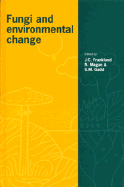Book contents
- Frontmatter
- Contents
- List of contributors
- Preface
- 1 Effects of climate change on fungal diseases of trees
- 2 Effects of climate change on Fusarium foot rot of winter wheat in the United Kingdom
- 3 Effects of UV-B radiation (280–320 nm) on foliar saprotrophs and pathogens
- 4 Implications of global warming and rising sea-levels for macrofungi in UK dune systems
- 5 Red Data Lists and decline in fruiting of macromycetes in relation to pollution and loss of habitat
- 6 Effects of dry-deposited SO2 and sulphite on saprotrophic fungi and decomposition of tree leaf litter
- 7 Effects of atmospheric pollutants on phyllosphere and endophytic fungi
- 8 Influences of acid mist and ozone on the fluorescein diacetate activity of leaf litter
- 9 Mycorrhizas and environmental stress
- 10 Myccorhizas, succession, and the rehabilitation of deforested lands in the humid tropics
- 11 Potential effects on the soil mycoflora of changes in the UK agricultural policy for upland grasslands
- 12 Uptake and immobilization of caesium in UK grassland and forest soils by fungi, following the Chernobyl accident
- 13 Effects of pollutants on aquatic hyphomycetes colonizing leaf material in freshwaters
- 14 Fungi and salt stress
- 15 Fungal sequestration, mobilization and transformation of metals and metalloids
- 16 Urban, industrial and agricultural effects on lichens
- 17 Fungal interactions with metals and radionuclides for environmental bioremediation
- 18 Impact of genetically-modified microorganisms on the terrestrial microbiota including fungi
- 19 Has chaos theory a place in environmental mycology?
- Index of generic and specific names
- Subject index
5 - Red Data Lists and decline in fruiting of macromycetes in relation to pollution and loss of habitat
Published online by Cambridge University Press: 05 November 2011
- Frontmatter
- Contents
- List of contributors
- Preface
- 1 Effects of climate change on fungal diseases of trees
- 2 Effects of climate change on Fusarium foot rot of winter wheat in the United Kingdom
- 3 Effects of UV-B radiation (280–320 nm) on foliar saprotrophs and pathogens
- 4 Implications of global warming and rising sea-levels for macrofungi in UK dune systems
- 5 Red Data Lists and decline in fruiting of macromycetes in relation to pollution and loss of habitat
- 6 Effects of dry-deposited SO2 and sulphite on saprotrophic fungi and decomposition of tree leaf litter
- 7 Effects of atmospheric pollutants on phyllosphere and endophytic fungi
- 8 Influences of acid mist and ozone on the fluorescein diacetate activity of leaf litter
- 9 Mycorrhizas and environmental stress
- 10 Myccorhizas, succession, and the rehabilitation of deforested lands in the humid tropics
- 11 Potential effects on the soil mycoflora of changes in the UK agricultural policy for upland grasslands
- 12 Uptake and immobilization of caesium in UK grassland and forest soils by fungi, following the Chernobyl accident
- 13 Effects of pollutants on aquatic hyphomycetes colonizing leaf material in freshwaters
- 14 Fungi and salt stress
- 15 Fungal sequestration, mobilization and transformation of metals and metalloids
- 16 Urban, industrial and agricultural effects on lichens
- 17 Fungal interactions with metals and radionuclides for environmental bioremediation
- 18 Impact of genetically-modified microorganisms on the terrestrial microbiota including fungi
- 19 Has chaos theory a place in environmental mycology?
- Index of generic and specific names
- Subject index
Summary
Introduction
The apparent decline, both in numbers of populations and in the geographical range, of macrofungi over several decades has aroused widespread concern in Europe. One demonstration of this is the publication of lists of species considered to be in danger of near-future extinction as a result of a complex of environmental changes. These Red Data Lists reflect this concern, both in size and composition of the lists of supposedly endangered species. Several European countries have produced such lists of endangered fungi: Austria (Krisai, 1986); the British Isles (Ing, 1992); Denmark (Vesterholt & Knudsen, 1990); Finland (Rassi et al., 1986); Germany (Benkert, 1982, 1993; Kreisel, 1992; Lettau, 1982; Runge, 1987; Schmitt, 1988; Winterhoff, 1984; Winterhoff & Krieglsteiner, 1984; Wöldecke, 1987); the Netherlands (Arnolds, 1989a); Norway (Bendiksen & Hølland, 1992); Poland (Wojewoda & Ławrinowicz, 1992) and Sweden (Ingelör, Thor & Hallingbäck, 1991). A provisional list for the whole of Europe has been offered by Ing (1993).
National lists differ in character, some reflecting local criteria based on the cultural importance of fungi rather than ecological priorities, and are necessarily parochial.
Composition of Red Lists
Species included in Red Lists are usually associated with ecosystems that are themselves endangered. In general, the majority are found in ancient woodland – both broad-leaved and coniferous, in unimproved grassland, in lowland bogs and sand dunes.
- Type
- Chapter
- Information
- Fungi and Environmental Change , pp. 61 - 69Publisher: Cambridge University PressPrint publication year: 1996
- 2
- Cited by

